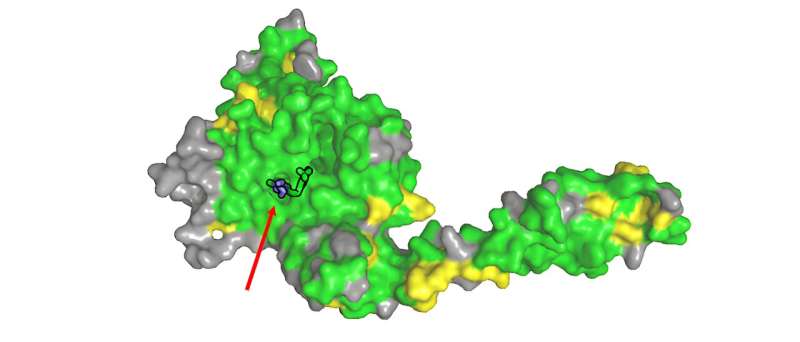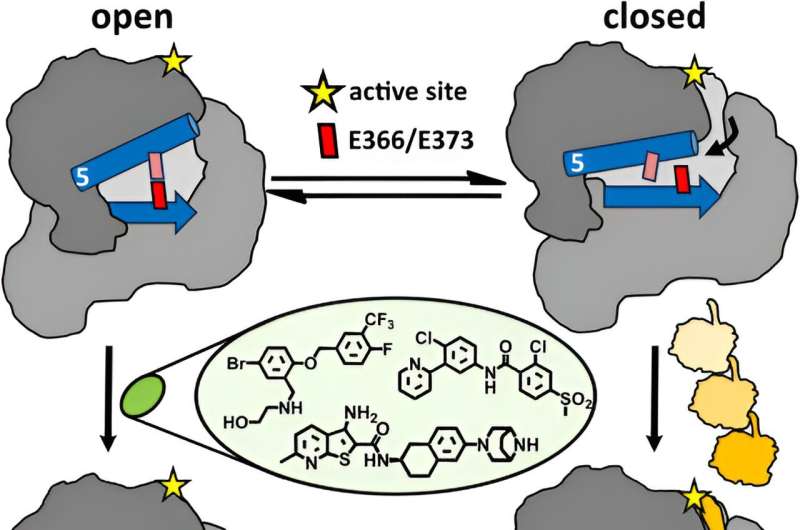This article has been reviewed according to Science X's editorial process and policies. Editors have highlighted the following attributes while ensuring the content's credibility:
fact-checked
peer-reviewed publication
trusted source
proofread
Enzyme research reveals why some cancer drugs cause severe side effects

Some cancer drugs cause severe side effects because they are not working accurately enough. A team at the University of Würzburg led by biochemist Caroline Kisker has now discovered why.
The small protein ubiquitin is involved in almost every cellular process in our body: it orchestrates the stability and function of the vast majority of proteins. When it binds to other proteins, they are often released for degradation. However, this labeling can also be reversed by special enzymes. The enzyme USP28, for example, is known to stabilize proteins that are important for cell growth and division—these can also play an important role in cancer growth.
In order to reduce the stability of these proteins and thus inhibit cancer growth, inhibitors of USP28 have been developed. These inhibitors, which form the basis of many anti-cancer drugs currently in development, disrupt cell division by blocking the USP28 enzyme. The problem is that they often act not only against USP28 but also against USP25, a closely related enzyme that separates ubiquitin from other proteins and is considered a key protein of the immune system.
Further development of USP28 inhibitors into therapeutics that can be used in the clinic is therefore very difficult because of the foreseeable side effects—ranging from gastrointestinal problems to nerve damage and even autoimmune diseases.

Risk of confusion between the two enzymes
Researchers at the University of Würzburg (JMU) have now discovered why inhibitors not only target USP28, but also USP25. "Apparently, there is a high risk of confusion between USP28 and USP25," explains Caroline Kisker, Chair of Structural Biology at the Rudolf Virchow Center in Würzburg and Vice President for Research and Young Scientists.
"We have been able to show that the two enzymes are very similar or even identical in many areas, including precisely where the inhibitors act."
As part of her research, the biochemist's team used X-ray crystallography to analyze the structure of USP28 in combination with the three inhibitors "AZ1," "Vismodegib" and "FT206"—and thus determine the spatial binding site.
Further biochemical experiments on USP25 showed that the sites where the inhibitors bind to USP28 and USP25 are identical. "The inhibitors are therefore unable to distinguish where they bind," says Kisker. "This explains the non-specific effect."
The study is published in the journal EMBO Reports.
Discovery paves the way for the development of precise inhibitors
The new scientific findings provide an important basis for the search for more specific drugs with fewer side effects. Their development is the next major goal of the Würzburg researchers.
"Our structural biology data allows us to modify existing inhibitors so that they only work against either USP25 or USP28," says Kisker. "We also want to look for inhibitors that bind to less similar enzyme sites. This will give these molecules greater targeting precision."
More information: Jonathan Vincent Patzke et al, Structural basis for the bi-specificity of USP25 and USP28 inhibitors, EMBO Reports (2024). DOI: 10.1038/s44319-024-00167-w
Journal information: EMBO Reports
Provided by Julius-Maximilians-Universität Würzburg



















